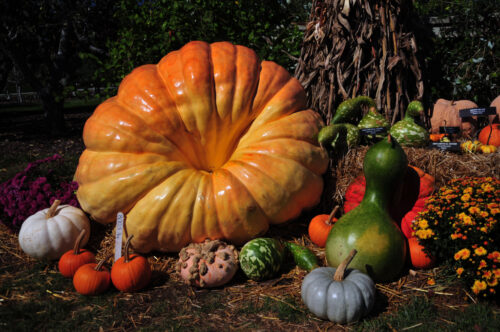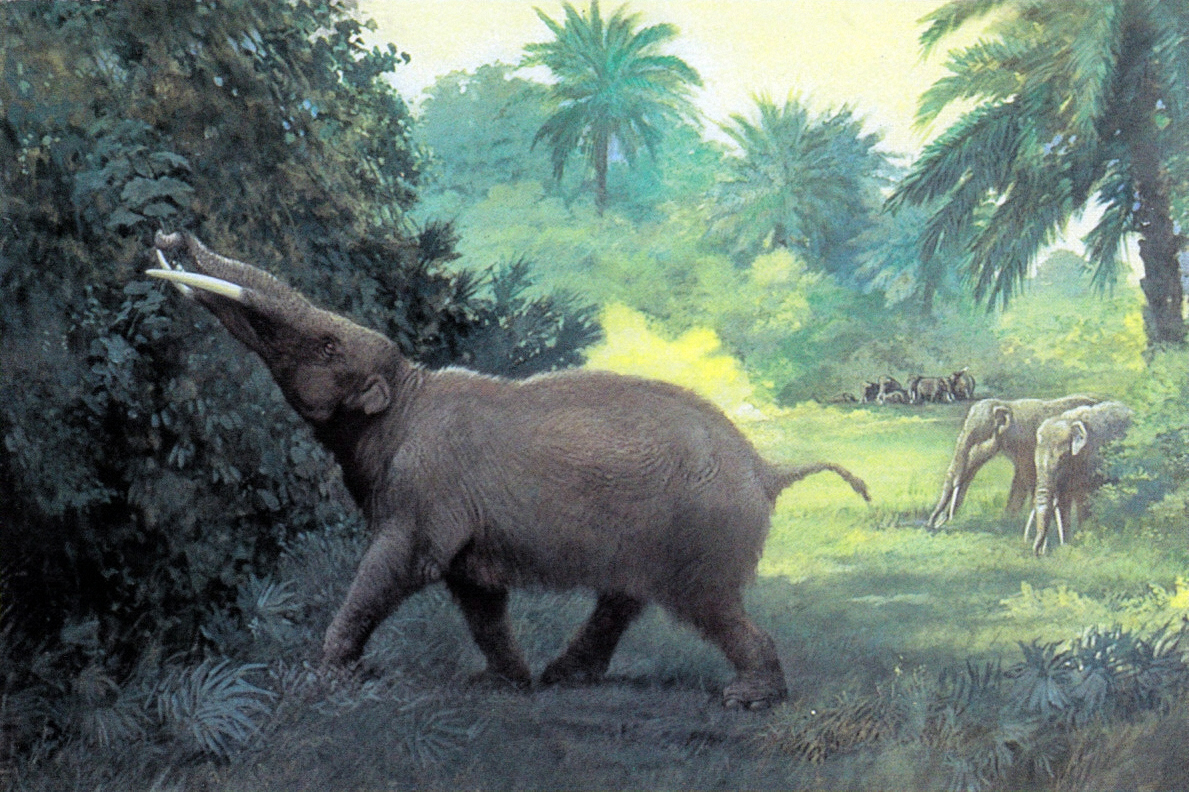
Late fall and winter usually mean lots of squash soups and pumpkin pies. These hearty fruits (yes, they’re all fruits!) are easy to grow even in harsh conditions, and can be stored for a long time, making them cold-weather staples. But their ubiquity today belies a truth recently uncovered — these plants all nearly went extinct just a few thousand years ago. Why did they decline, and what brought them back? The answer to both questions, of course, is the same: evolution.
Where's the evolution?
Pumpkins, squashes (everything from butternut squash to zucchini), and many types of gourds all belong to the genus Cucurbita. For thousands of years, humans have cultivated Cucurbita plants and used their fruits not only for food, but also as decoration, containers, and for making music. The wild ancestors of Cucurbita plants were largely a mystery until some samples of fossilized mastodon dung got Penn State anthropologist Logan Kistler thinking. The dung contained a plethora of squash seeds, which made Kistler wonder — since mastodons are extinct, were cucurbits evolutionary anachronisms?
The term “evolutionary anachronism” can be traced back to a 1982 Science paper by Daniel Janzen and Paul Martin. In the paper, Janzen and Martin describe anachronistic plants as those with traits that once enhanced dispersal and increased fitness, but that are today no longer adaptive because the plants’ main seed-dispersers have gone extinct. For an example, you needn’t look further than the everyday avocado. An avocado plant produces fruits with massive seeds. There is no wild animal (except humans) in the avocado plant’s native Central America that can disperse avocado seeds today. But that wasn’t always the case. Go back between 125,000–11,000 years ago and you’d find that ecosystems in the Americas were populated with some very large herbivores — members of a group known as the Pleistocene megafauna.

Megafauna translates literally to “big animal.” Here, I apply the term to land animals with masses greater than 1,000 kg (about 2,000 lb.). By this definition, elephants are the only examples of living megafauna, but before the end of the last ice age, megafauna were far more diverse. In the Americas, mammoths, mastodons, giant ground sloths, and gomphotheres were plentiful. Each of these giants was herbivorous, relying on a daily feast of plants to keep their massive bodies working. By 10,000 years ago, the last of the Pleistocene megafauna went extinct, which led to a dramatic shifting of new world landscapes. Many plants that had relied on megafauna for dispersal went extinct, but a few — such as the avocado — squeaked by. When Kistler heard about mastodon dung strewn with squash seeds he wondered if wild Cucurbita ancestors had been affected by the megafauna extinction.
To begin testing the hypothesis, Kistler and his team compared a portion of the genome across 91 ancient, wild, and domesticated cucurbits. From their analysis, they concluded that humans began growing cucurbits around 10,000 years ago. As for wild populations, the closest wild relatives of C. pepo pepo (the subspecies designation for zucchini, pumpkins, and summer and winter squashes) went extinct, while the wild relatives of other Cucurbita species have persisted, albeit in restricted and fragmented populations. Taken together, the genetic data suggest that domestication of cucurbits coincided with a loss of diversity in the wild triggered by the megafauna extinction.
But why were so many wild species of Cucurbita lost when the megafauna went extinct? Squashes and pumpkins don’t have giant seeds that can only be dispersed by large animals; they tend to have hundreds of small seeds perfectly suited to dispersal by anything from a mouse to a deer. So what was the problem? Turns out, it wasn’t the size of the seed that was an issue — it was the poison in the fruit.
Given the sweet deliciousness of many Cucurbita varieties (who doesn’t like pumpkin ravioli on a chilly night?) it may be surprising that the wild ancestors of these plants all bore incredibly bitter fruits owing to a high concentration of chemicals called cucurbitacins. According to Kistler and colleagues, the intense bitterness of wild cucurbits would have dissuaded most animals (including humans) from taking a nibble. Why didn’t the bitterness put off the megafauna? Because it turns out they probably couldn’t have detected the bitterness at all. Kistler and his team searched the genomes of 38 mammals for functional TAS2R genes. TAS2R genes detect bitterness — the more functional copies of the genes you have, the more sensitive to bitterness you tend to be.
Their analysis showed a clear relationship: the larger the mammal, the fewer copies of functional TAS2R gene in the genome. At the extremes, the West Indian manatee has 8 TAS2R copes, while the common shrew has 46! From these data, it’s possible to infer that the enormous megafauna herbivores had only a few functional TAS2R genes and were therefore not bothered by a sense of bitterness. The data also correlate with degree of diet specialization. Shrews are browsers and opportunists, while manatees eat a restricted set of aquatic plants. Since bitter taste is often a sign of poison, the advantage of a discerning palette among small generalist eaters is obvious. Only a small amount of poison would be necessary to kill a small animal, and eating anything available makes it a relative certainty that that small animal would come across something poisonous. Therefore detection — and avoidance — of even a trace of bitterness would be a key to survival.
But another question emerges from this line of inquiry: Why were wild cucurbits all so bitter and poisonous? What was the advantage to forming a mutualism with only the largest of potential seed dispersers? Kistler’s team thinks that it’s because the smaller animals would not have been large enough to swallow the fruits whole, so they might have acted more like “seed predators” than seed dispersers. With fruits so poisonous and bitter so as to discourage all but the largest herbivores, cucurbits increased their fitness.
This strategy, however, would have left Cucurbita species particularly vulnerable once the megafauna went extinct. Couple that to the fact that cucurbits thrive in the weedy, disturbed areas shaped by the megafauna and you’ve got a perfect recipe for extinction. But they didn’t all go extinct — and we humans are the reason. Exactly how a relationship formed between ancient humans and cucurbits is not known. A single bite of a wild Cucurbita fruit can cause acute gastronomic distress in a person, so it is highly unlikely that our ancestors simply picked up where the megafauna left off. Perhaps, though, humans began to use certain cucurbits for decoration, music, or tools and inadvertently began selecting for less toxic, less bitter varieties. Or maybe humans managed to hone in on palatable, less-poisonous individuals and in eating them and releasing seeds in their waste, provided a selection factor for less bitter, less poisonous variants. However it happened, over time, cucurbits and humans found a new mutualism. We got delicious, nutritious, hearty fruits and they got to live on. Kistler maintains that key to this domestication would have been a near complete end to gene flow between wild and domesticated populations. Without it, cross-fertilization would have readily maintained bitterness and toxicity. In this way, we should be grateful to the extinction and scarcity of Cucurbita‘s wild counterparts because without it, our pumpkin spiced lattes might be a whole lot less sweet.
Primary literature:
- Kistler, L., Newsom, L.A., Ryan, T.M., Clarke, A.C., Smith, B.D., Perry, G.H. (2015). Gourds and squashes (Cucurbita spp.) adapted to megafaunal extinction and ecological anachronism through domestication. PNAS. doi: 10.1073/pnas.151610911. Read it »
News articles:
- A post summarizing the research from National Geographic's "Not Exactly Rocket Science" blog
- A press release from Penn State University
- An article about the anachronistic avocado from Smithsonian Magazine
- An account of the research from CNN
Understanding Evolution resources:
- An Evolution in the News article about mass extinctions and what happens after them
- An explanation of common misconceptions about mass extinctions
- An Evolution in the News article about using genetics to trace the wild ancestors of domesticated animals and plants
- A short piece about maize and its wild ancestor, teosinte
- In your own words, explain what it means if a plant is described as an evolutionary anachronism.
- Wild avocado ancestors had even larger seeds and less edible flesh. Through cultivation, humans reduced the ratio of seed to flesh. Is this an example of evolution by natural selection or artificial selection? Explain your answer.
- The relationship between Cucurbita plants and their seed dispersers is described as mutualistic. What is a mutualistic relationship?
- After reading this story, a student claims that cucurbits tried to become less toxic and less bitter so that humans could eat them. What misconception is this student exhibiting? Can you correct the statement?
- Advanced: Use the Internet or other resources to find five other examples of evolutionary anachronisms. Describe similarities and differences among the examples you find.
- Short film and related classroom resources on the domestication of maize from HHMI Biointeractive
- An engaging short video about evolutionary anachronisms
- An article about possible causes for the Pleistocene megafauna extinction
- A video field trip to San Francisco...in the Pleistocene
- A video explaining the significance of dancing with gourds to the Native American Zuni
- Guimaráes, P.R. Jr., Galetti, M., Jordano, P. (2008). Seed dispersal anachronisms: Rethinking the fruits extinct megafauna ate. PLOSone. doi: 10.1371/journal.pone.0001745.
- Janzen, D.H. and Martin, P.S. (1982). Neotropical anachronisms: The fruits the gomphotheres ate. Science:215, p.19–27.
